Fletcher Building Bundle
How well do you know Fletcher Building?
Embark on a journey through the fascinating Fletcher Building SWOT Analysis, a cornerstone of the New Zealand construction industry. From its humble beginnings in 1908, this building company has evolved into a construction powerhouse. Discover the key milestones and challenges that have shaped Fletcher Building's impressive legacy.
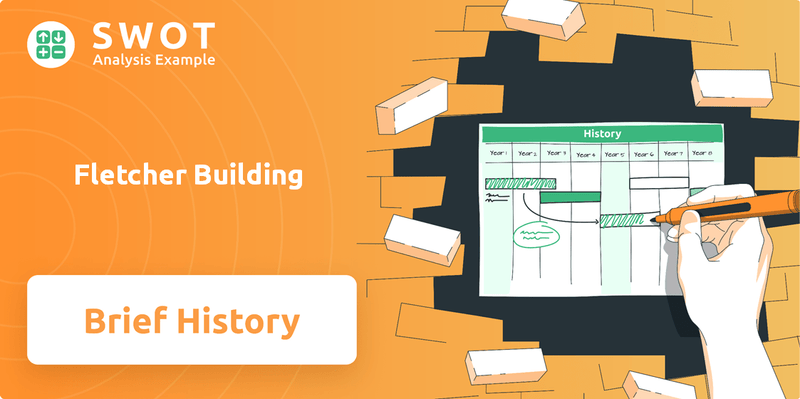
This exploration into the brief history of Fletcher Building will uncover the early years of the company, tracing its expansion from residential construction to significant public works and commercial projects. Understanding the Fletcher Building Company timeline provides valuable insights into the evolution of the New Zealand construction industry. Learn about the Fletcher Building Company founders and the strategic decisions that propelled its growth, including key acquisitions and projects that defined its success.
What is the Fletcher Building Founding Story?
The founding story of Fletcher Building, a prominent player in the New Zealand construction industry, began with a modest start. James Fletcher, arriving in 1908, laid the groundwork for what would become a significant enterprise. This early history offers insights into the company's evolution and its impact on the construction landscape.
The initial focus was on residential construction, gradually expanding to encompass larger projects. This strategic shift, coupled with acquisitions, propelled the company's growth. The company's early financial strategies and project selections shaped its trajectory.
James Fletcher, a Scottish immigrant, arrived in Dunedin, New Zealand, in 1908 with twelve pounds, setting the stage for the future Mission, Vision & Core Values of Fletcher Building.
- In 1909, James Fletcher and Albert Morris secured their first building contract for a wooden villa.
- In January 1911, James Fletcher and Albert Morris refocused on building houses in Abbotsford and South Dunedin.
- William John Fletcher joined the firm in the summer of 1911, investing $1000 and becoming an equal partner.
- The company was renamed Fletcher Brothers after Albert Morris's departure in May 1912.
- Fletcher Bros Ltd was formally incorporated in 1915.
- The first major non-domestic commission was a Coronation Hall in November 1911.
- The company expanded to include businesses that supplied building materials.
Fletcher Building SWOT Analysis
- Complete SWOT Breakdown
- Fully Customizable
- Editable in Excel & Word
- Professional Formatting
- Investor-Ready Format
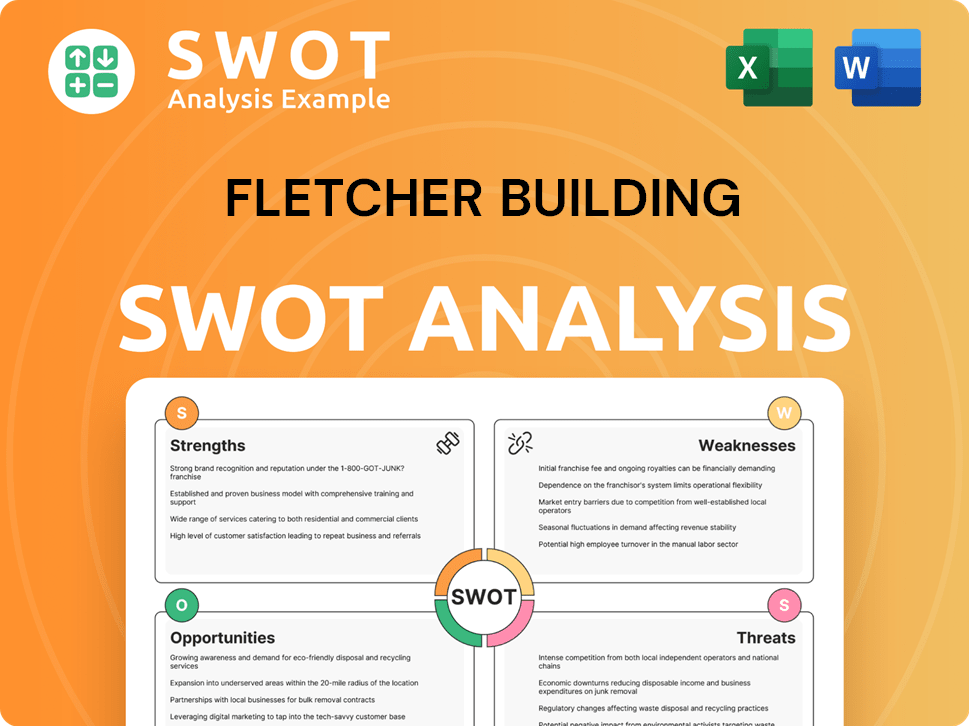
What Drove the Early Growth of Fletcher Building?
The early years of what is now known as Fletcher Building were marked by rapid growth and strategic diversification within the New Zealand construction industry. Established as Fletcher Bros Ltd in 1915, the company quickly evolved, becoming Fletcher Construction by 1919. This period saw the expansion of operations and the undertaking of significant public works projects.
Fletcher Construction extended its reach, establishing a presence in Auckland and Wellington. The company's headquarters were relocated to Auckland in 1925. During the Depression era, Fletcher Construction took on major projects like the Civic Theatre in Auckland and the Dominion Museum and railway station in Wellington. This period also saw the strategic acquisition of timber mills, a marble quarry, and shares in the brick-making industry, alongside the establishment of a joinery factory and a concrete manufacturer.
In 1940, the company went public as Fletcher Holdings, with Fletcher Construction continuing as a subsidiary. Post-World War II, Fletcher Holdings ventured into international markets through joint ventures. This included the formation of Fletcher South Seas Limited in Samoa in 1946 and the commencement of operations in Australia three years later. Major projects included a construction contract at Auckland Harbour in 1951, in a joint venture with American companies, and the formation of the Tasman Pulp and Paper Company in 1952 in partnership with the New Zealand government.
The early 1980s saw the creation of Fletcher Challenge in 1981 through a merger of Fletcher Holdings, Challenge Corporation, and Tasman Pulp and Paper. This merger created a large multinational company, diversifying into forestry, paper, pulp, meat processing, gas distribution, and fisheries. By the 1990s, the company refocused on its core building, building products, and home environments businesses, divesting non-core assets. This strategic shift culminated in 2001 with the dismantling of Fletcher Challenge and the establishment of Fletcher Building Limited as a stand-alone, publicly listed entity.
The new Fletcher Building started with low gearing and credit risk, which enabled strategic acquisitions throughout the 2000s to expand its domestic and international operations. As of 2024, the company continues to be a significant player in the New Zealand construction and building products market, with a focus on sustainable building practices and innovative construction solutions. In 2024, the company's revenue was approximately $8.4 billion, demonstrating its continued influence in the industry.
Fletcher Building PESTLE Analysis
- Covers All 6 PESTLE Categories
- No Research Needed – Save Hours of Work
- Built by Experts, Trusted by Consultants
- Instant Download, Ready to Use
- 100% Editable, Fully Customizable
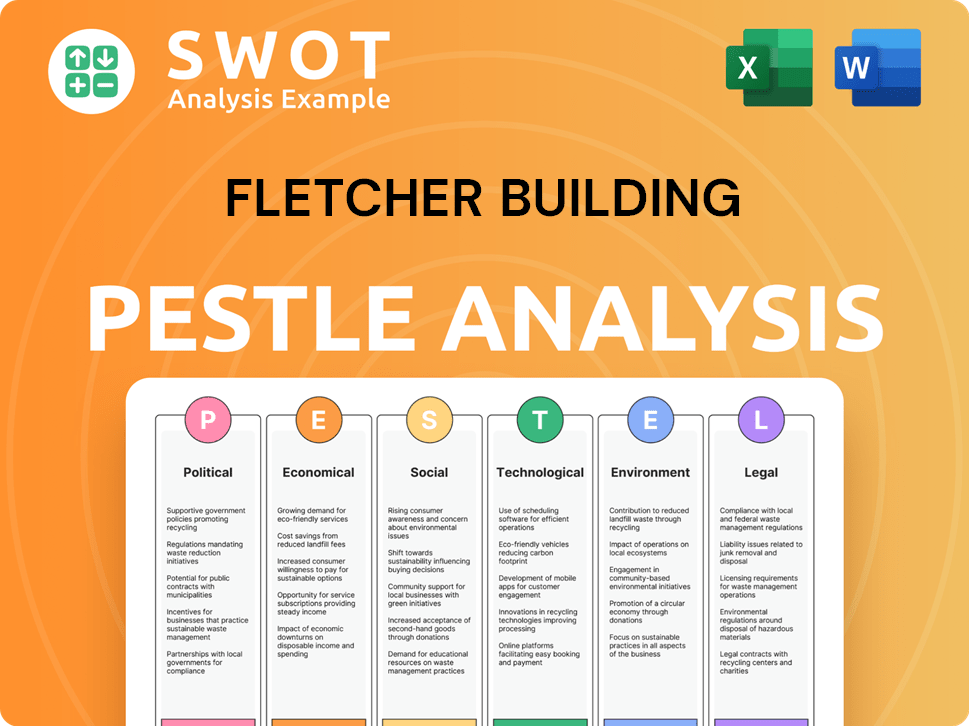
What are the key Milestones in Fletcher Building history?
The Fletcher Building history is marked by significant achievements, solidifying its place as a key player in the New Zealand construction and building company sectors. The company has grown from its early beginnings to become a major force in the industry, navigating through various economic cycles and market shifts.
| Year | Milestone |
|---|---|
| Late 1920s | Introduction of US-styled brick and tile houses. |
| Late 1930s | Creation of New Zealand's first ready-mix concrete business. |
| May 2007 | Acquisition of Formica Group, a major manufacturer of decorative surfaces. |
| Various Years | Acquisition of civil construction businesses Higgins and Calder Stewart Roofing. |
| September 2024 | Completed an NZ$700 million equity raise. |
Throughout its history, Fletcher Building has consistently introduced innovative solutions to the construction industry. These innovations have not only shaped the company's growth but also influenced the broader construction industry in New Zealand.
The company pioneered the introduction of US-styled brick and tile houses in the late 1920s. Furthermore, they established New Zealand's first ready-mix concrete business in the late 1930s.
Acquisitions like Formica Group in May 2007 and civil construction businesses Higgins and Calder Stewart Roofing expanded its portfolio. These strategic moves strengthened its market position and diversified its offerings.
Fletcher Building has faced numerous challenges, reflecting the cyclical nature of the construction industry and broader economic impacts. These challenges have tested the company's resilience and strategic adaptability.
The Asian financial crisis of 1997 significantly impacted its pulp and paper industry interests. This event highlighted the vulnerability of the company's diverse business interests to global economic downturns.
Project delays and cost overruns, particularly in the construction division, have been a major challenge. The New Zealand International Convention Centre project is a notable example, incurring substantial losses.
The company reported a net loss of NZ$120 million in the first half of its 2025 financial year. This included provisions and writedowns, leading to restructuring efforts and a cost-out program.
The COVID-19 pandemic led to significant layoffs, with approximately 1000 staff laid off in New Zealand, and financial losses. The pandemic also contributed to a nationwide plasterboard shortage.
Leadership changes, including the resignation of CEO Ross Taylor and Chairman Bruce Hassall in late 2024, reflect the pressures faced by the company. These changes signal a period of transition and strategic realignment.
In response to these challenges, Fletcher Building completed an NZ$700 million equity raise in September 2024. This move aimed to bolster its financial position and reduce debt.
Fletcher Building Business Model Canvas
- Complete 9-Block Business Model Canvas
- Effortlessly Communicate Your Business Strategy
- Investor-Ready BMC Format
- 100% Editable and Customizable
- Clear and Structured Layout
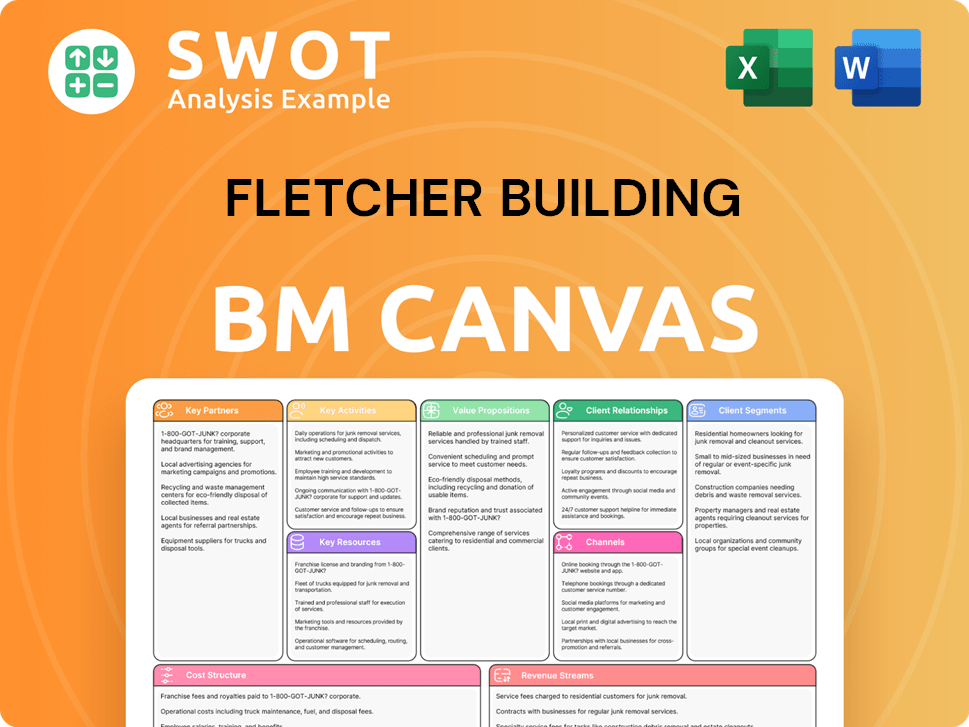
What is the Timeline of Key Events for Fletcher Building?
The Owners & Shareholders of Fletcher Building have witnessed a long history, marked by significant milestones in the New Zealand construction industry. From humble beginnings building houses to becoming a publicly listed entity, the company has evolved considerably. The company has navigated economic cycles, expansions, and challenges, including the recent impact of the COVID-19 pandemic and regulatory scrutiny over plasterboard shortages. The company’s journey reflects the broader trends in the construction and building company sectors.
| Year | Key Event |
|---|---|
| 1908 | James Fletcher begins building houses in Dunedin, New Zealand, marking the start of the company's history. |
| 1915 | Fletcher Bros Ltd is incorporated, formalizing the company's operations. |
| 1919 | The company becomes known as Fletcher Construction, reflecting its expanding scope. |
| 1925 | Company headquarters move to Auckland, a strategic shift for growth. |
| 1940 | The company goes public as Fletcher Holdings, a significant step in its evolution. |
| 1946 | Fletcher South Seas Limited is formed in Samoa, expanding its presence. |
| 1949 | Operations begin in Australia, marking international expansion. |
| 1952 | Tasman Pulp and Paper Company is formed in a joint venture with the New Zealand government. |
| 1981 | Fletcher Holdings merges with Challenge Corporation and Tasman Pulp and Paper to form Fletcher Challenge. |
| 2001 | Fletcher Building Limited is established as a stand-alone, publicly listed entity. |
| 2007 | Fletcher Building acquires Formica Group, expanding its portfolio. |
| 2019 | SkyCity Convention Centre fire impacts the construction division. |
| 2020 | COVID-19 pandemic leads to layoffs and financial losses. |
| 2022 | Nationwide plasterboard shortage leads to regulatory scrutiny. |
| 2024 (August) | Reports net loss; new CEO Andrew Reding appointed. |
| 2024 (September) | Completes NZ$700 million equity raise. |
| 2025 (February) | Reports net loss of $134 million for the first half of FY25. |
Fletcher Building faces ongoing challenges in both New Zealand and Australian markets. The company anticipates difficult trading conditions, slowing demand, and intense competition. Persistent inflationary pressures are also a concern. These factors will influence the construction industry.
The company's strategy includes optimizing operational performance and tightly managing costs. They aim for over $200 million in gross cost reductions for FY25. Prudent capital expenditure and resolving legacy issues, such as plumbing failures, are also key priorities.
Analyst predictions suggest a challenging near-term outlook. A 24% decline in fiscal 2025 adjusted EBIT is forecast, based on lower volumes and margin compression. A revenue compound annual growth rate of 3% is expected longer-term, supported by new residential construction.
Fletcher Building continues to focus on its core markets of New Zealand and Australia. The company aims to improve the world through smart solutions, aligning with James Fletcher's original vision. They are dedicated to building essential infrastructure and homes.
Fletcher Building Porter's Five Forces Analysis
- Covers All 5 Competitive Forces in Detail
- Structured for Consultants, Students, and Founders
- 100% Editable in Microsoft Word & Excel
- Instant Digital Download – Use Immediately
- Compatible with Mac & PC – Fully Unlocked
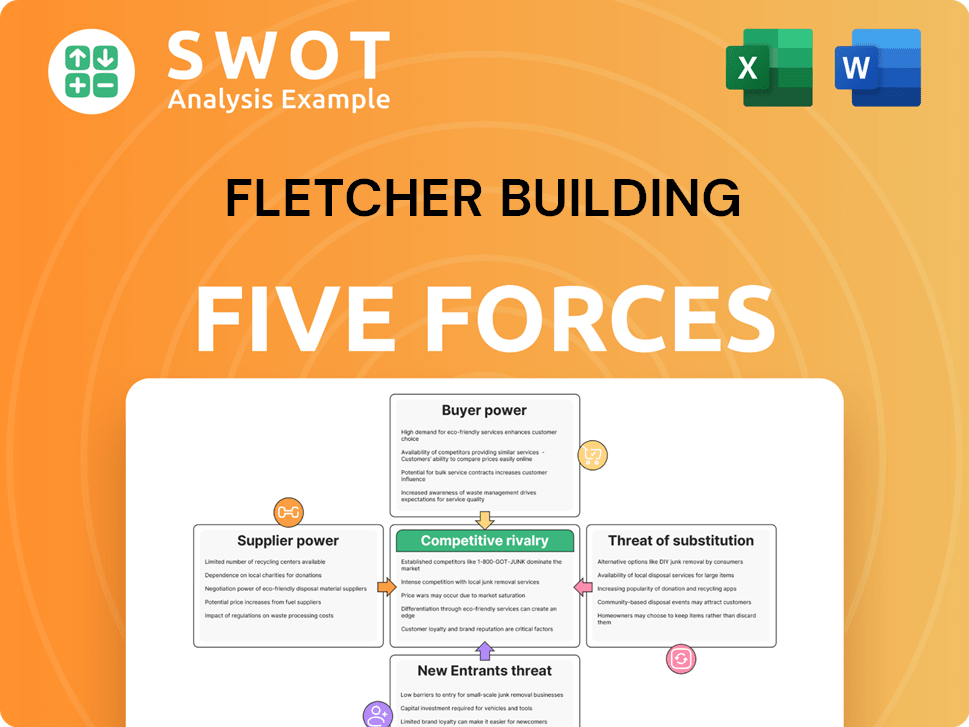
Related Blogs
- What is Competitive Landscape of Fletcher Building Company?
- What is Growth Strategy and Future Prospects of Fletcher Building Company?
- How Does Fletcher Building Company Work?
- What is Sales and Marketing Strategy of Fletcher Building Company?
- What is Brief History of Fletcher Building Company?
- Who Owns Fletcher Building Company?
- What is Customer Demographics and Target Market of Fletcher Building Company?
Disclaimer
All information, articles, and product details provided on this website are for general informational and educational purposes only. We do not claim any ownership over, nor do we intend to infringe upon, any trademarks, copyrights, logos, brand names, or other intellectual property mentioned or depicted on this site. Such intellectual property remains the property of its respective owners, and any references here are made solely for identification or informational purposes, without implying any affiliation, endorsement, or partnership.
We make no representations or warranties, express or implied, regarding the accuracy, completeness, or suitability of any content or products presented. Nothing on this website should be construed as legal, tax, investment, financial, medical, or other professional advice. In addition, no part of this site—including articles or product references—constitutes a solicitation, recommendation, endorsement, advertisement, or offer to buy or sell any securities, franchises, or other financial instruments, particularly in jurisdictions where such activity would be unlawful.
All content is of a general nature and may not address the specific circumstances of any individual or entity. It is not a substitute for professional advice or services. Any actions you take based on the information provided here are strictly at your own risk. You accept full responsibility for any decisions or outcomes arising from your use of this website and agree to release us from any liability in connection with your use of, or reliance upon, the content or products found herein.